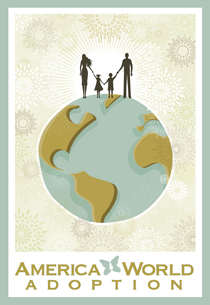
When we started sharing that we would be adopting a little boy from Ethiopia, the thing people were most curious about was if he would be able to speak English. We knew it was doubtful he would, and while we expected it would be an interesting transition, we didn’t really have any reservations about it. After all, years before we had been told that Samantha, our oldest who was born deaf, would likely never learn to talk, and she has beautiful speech. We had spent countless hours observing and participating in speech and language lessons with Samantha. We knew how to make teaching prepositions into a game. We could wallpaper our entire house with vocabulary cards. We were not intimidated.
When we met Trey during our first trip to Ethiopia, with the exception of the primal howling he used to express his grief and fear, he was extremely quiet. The primary language spoken by the staff at the Transition Home, and by most people in the capital city of Addis Ababa, is Amharic, the national language of Ethiopia. Some of the staff were also fluent in English, which is the most widely spoken foreign language in Ethiopia. Trey, being from the southern part of Ethiopia known as the Sidama Zone, was only familiar with the native language Sidama (or Sidamigna). The staff explained that because of this language barrier, it was very difficult for them to communicate with him. While older children at the Transition Home are often able to pick up common English words and phrases, Trey had the additional challenge of translating words from Sidama to Amharic, and from Amharic to English.
For the first seven days after leaving the Transition Home, Trey barely made a sound. He would give a quick upward jerk of the head to indicate a “yes”. He would tilt his head to one shoulder while raising the same shoulder to his chin to indicate a “no”. This is the Ethiopian equivalent of nodding yes and shaking your head no. However, he refused to make any effort to communicate verbally. I know seven days does not seem like much, but let me say, seven days can seem like a very long time with a 5-year-old child who only jerks and tilts his head to communicate. We were prepared to bring home a child who needed help learning how to speak, but didn’t know quite what to do about a child who was refusing to speak.
On the seventh night, Dave sat down on the edge of Trey’s bed to tell him goodnight. He asked him if he wanted to try to say his ABCs. After no response, Dave started with an “A…” and waited. After a few seconds, in a little raspy voice, Trey repeated an “A”. Then a ”B”. Then a “C”. He continued through the entire alphabet before falling asleep. Not wanting to interrupt, I listened in from the adjoining room and enjoyed the sweet relief of finally hearing his voice.
Trey has been home for three months now, and if we made a list of characteristics that describe Trey, “quiet” would not be one of them. He’s done an amazing job of picking up the English language and has become quite the chatterbox. Obviously, he has a long way to go to catch up with his American-born peers, but he adds new words to his vocabulary daily. He has a cute Ethiopian accent which we find both entertaining and endearing. For example, elephant is pronounced e-lay-font, and “Canasa feesh?” simply means “Can I have some Goldfish?” The R and Th sounds are very tricky, and pronouns are beyond confusing. He also feels he should add his name to the end of almost everything he says. “I grocery store go with Mommy…Trey.”
While we do make efforts to guide Trey’s language, most of what he has learned has come through simply observing everyday family communication. He does a good job imitating our words and phrases, which sometimes provides a comical glimpse into the things that have come out of our own mouths. For example, the other day Trey ran off to play, leaving a mess behind for someone else to clean up. When I asked him to come talk to me about it, he was very compliant. I asked him if he had made the mess, and he agreed that he had. I reminded him that he needed to clean up his messes and to ask for help if he needed it. He nodded in agreement. I then asked him “why” he didn’t clean up his mess. While he will ask “why?” a hundred times a day, it is a very difficult question for him to answer. Still, I like to give him the opportunity and see what he comes up with. I could tell by his facial expressions he was trying to come up with a suitable answer. After a very long pause, he slowly responded in a hesitant voice, “Because I said so???”
While asking “why?” is a constant throughout the day, it doesn’t touch Trey’s favorite phrase: “What is this?” (or “What is thees?”). He wants to know what everything is. Everything.
When he notices a small screw in the handle of the shopping cart…”What is thees?”
When he picks a miniscule piece of lint from his beach towel…“What is thees?”
When he spies a smudge on the window of a car in the parking lot of a restaurant…”What is thees?
All of this question-asking provides a wonderful teaching opportunity and should undoubtedly be credited for his rapidly expanding vocabulary, but I sometimes have to shake my head and confess that I don’t know “what thees is.” Sometimes I am just all talked-out.
Finally, Trey also has learned that he can have an entire conversation and gain a great deal of information simply by using the word “and”.
Mom: Trey, we are leaving soon. Please put on your shoes.
Trey: And?
Mom: And then we will go to the library.
Trey: And?
Mom: And we are going to check out some new books.
Trey: And?
Mom: And we will bring them home.
Trey: And?
Mom: And we will read them together.
Trey: And?
Mom: And that’s all. Put on your shoes.
Trey: And?
Mom: And that’s all.


 We are Dave and Robyn Davidson of St. Louis, Missouri. We have three sweet and spunky kids: Samantha, Toby, and Trey. Welcome to our Jesus adoring, miracle believing, gymnastics loving, football cheering, road tripping, frog catching, very blessed, busy family blog.
We are Dave and Robyn Davidson of St. Louis, Missouri. We have three sweet and spunky kids: Samantha, Toby, and Trey. Welcome to our Jesus adoring, miracle believing, gymnastics loving, football cheering, road tripping, frog catching, very blessed, busy family blog.









